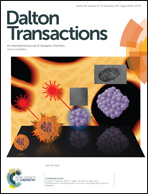Speciation of americium in seawater and accumulation in the marine sponge Aplysina cavernicola†
Abstract
The fate of radionuclides in the environment is a cause of great concern for modern society, seen especially in 2011 after the Fukushima accident. Among the environmental compartments, seawater covers most of the earth's surface and may be directly or indirectly impacted. The interaction between radionuclides and the marine compartment is therefore essential for better understanding the transfer mechanisms from the hydrosphere to the biosphere. This information allows for the evaluation of the impact on humans via our interaction with the biotope that has been largely undocumented up to now. In this report, we attempt to make a link between the speciation of heavy elements in natural seawater and their uptake by a model marine organism. More specifically, because the interaction of actinides with marine invertebrates has been poorly studied, the accumulation in a representative member of the Mediterranean coralligenous habitat, the sponge Aplysina cavernicola, was investigated and its uptake curve exposed to a radiotracer 241Am was estimated using a high-purity Ge gamma spectrometer. But in order to go beyond the phenomenological accumulation rate, the speciation of americium(III) in seawater must be assessed. The speciation of 241Am (and natural europium as its chemically stable surrogate) in seawater was determined using a combination of different techniques: Time-Resolved Laser-Induced Fluorescence (TRLIF), Extended X-ray Absorption Fine Structure (EXAFS) at the LIII edge, Attenuated Total Reflectance Fourier Transform Infrared (ATR-FTIR) spectroscopy and Scanning Electron Microscopy (SEM) and the resulting data were compared with the speciation modeling. In seawater, the americium(III) complex (as well as the corresponding europium complex, although with conformational differences) was identified as a ternary sodium biscarbonato complex, whose formula can be tentatively written as NaAm(CO3)2·nH2O. It is therefore this chemical form of americium that is accumulated by the sponge A. cavernicola.


 Please wait while we load your content...
Please wait while we load your content...